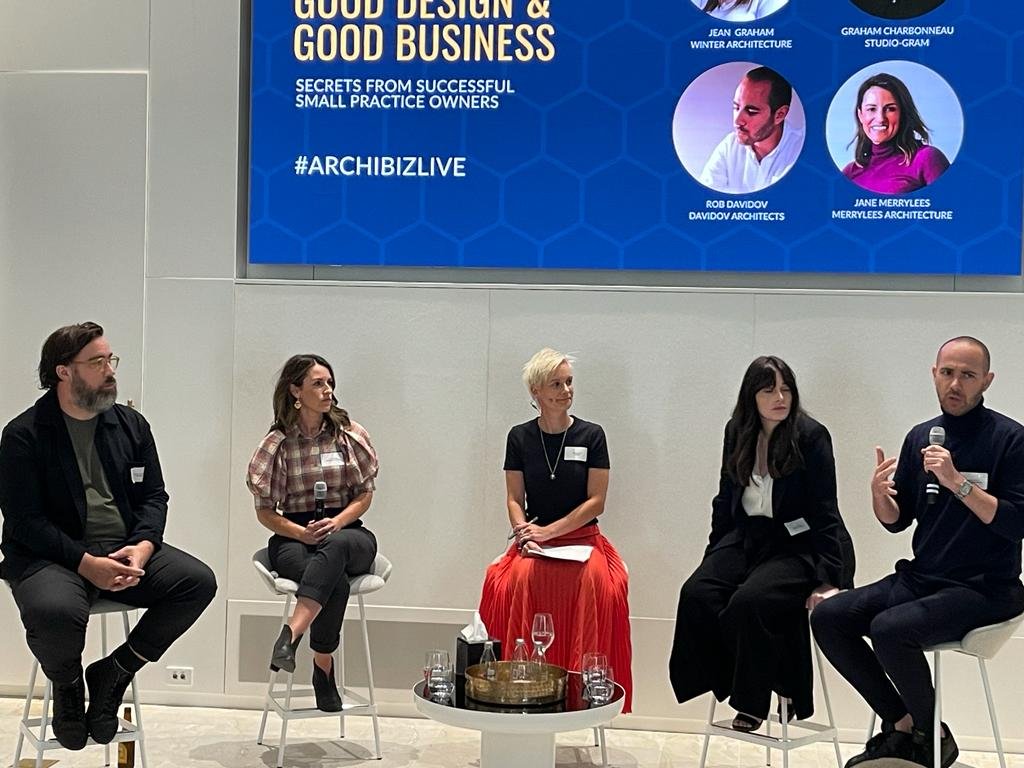When an architect starts their own practice, there’s a shift that occurs.
Rather than focusing solely on the design of their projects, they now have to think about business. They have to think about how much the project will cost them, the right fees to charge so that the firm makes a profit, how many staff members it will require, and so on.
This creates a tension between design and business. How can you balance both good design and good business without sacrificing one over the other?
Last week, ArchiBiz CEO Bec Kempster sat down with four of Australia’s leading small practice architects to discuss how they navigate balancing good design with good business in their studios. The event, hosted at Brickworks Design Studio in Melbourne, explored some of the challenges that small practice owners face as they try to grow their practices in income and impact.
Graham Charbonneau, Co-Founder at studio-gram, said that “good design is a key principle” at his Adelaide-based practice. Historically, that’s sometimes meant that good business – or profit – has had to suffer.
“We’re very aware that some of our best projects didn’t make us any money in terms of profit,” he said. “After seven years of our practice, we realized we didn’t know any more about running a business from when we started, so we decided to dedicate some time towards that.”
To him and his partner Dave Bickmore, good business means avoiding the “churn and burn” that is so common at most architectural firms. While not everyone works on every project, Graham said you’ll often see people pitching in to help on projects when needed. So, rather than having one or two people work until midnight, there will be seven people working until 7 p.m. and embracing the “team mentality.”
For Jane Merrylees, good business means keeping her team of eight happy.
“A key part of good business is culture, and having a happy team helps enable them to deliver good work” she said. “People and culture are the most important things to get right at this stage. I want them to feel like they’re a part of something and contributing.”
As Merrylees Architecture & Interiors grew, that meant that Jane had to change the way she ran her business. She’s now implemented bi-annual and annual performance reviews, impromptu “walk and talks” with staff members, and holiday bonuses.
At Davidov Architects, founder Rob Davidov said that good business has always been a key and “conscious decision.” He’s always made sure he paid himself a proper wage, respected his hours and treated clients in a professional manner.
More recently, after working with ArchiBiz, Rob’s definition of “good business” has grown.
“Working with [ArchiBiz Chief Mentor] Ray and ArchiBiz helped me develop much more stringent systems,” he said. “I’m now looking at the pipeline and other metrics on a monthly basis, and that’s definitely helped with the decision making. I’m able to look forward with a lot more clarity.”
At ArchiBiz, we offer business coaching and mentoring to architecture practice leaders who are looking to build profitable and impactful practices. To inquire about coaching, contact us directly by filling out this form, and we’ll find a time to chat about your needs and how ArchiBiz can help.

Managing project hours
While good business might look different at each practice, there is one aspect of business that plagues every practice owner: managing and billing project hours. As Bec pointed out, getting paid correctly for project hours is the key to striking the balance between good business and good design.
For Jean Graham, director of Winter Architecture, nailing this part of her business meant she had to start measuring data in her business. By deeply analyzing her firm’s output and rates, she was able to establish hourly rates that were reasonable to her and her clients.
Ultimately, after working with ArchiBiz, she’s “learned to charge for her value and not just her time,” she said.
Similarly, Jane said she’s been increasingly tracking her time and invoicing regularly at Merrylees Architecture. However, it doesn’t always work out as planned.
“We often get to a stage at the end of the project and we’ve run out of fees, but we would never compromise on output at the last stage because we care about the end product,” she said. “It’s also quite possible that we were profitable at earlier stages anyway.”
At studio-gram, software has made all the difference.
After implementing Monograph, a practice management software that helps the practice with invoicing and project management, Graham said there is greater “ownership” in the team. Each staff member knows exactly the amount of paid hours that they are allocated to work on a certain aspect of a job, thus becoming more responsible at making sure those hours are used appropriately.
What’s making an impact
Beyond software, there are many different components that go into a successful architecture practice.
At Davidov Architects, one of the most impactful changes that Rob has made in the business was learning not to give any work away for free. That means no free sketches for anyone, not even his dream project.
“We’re so used to giving ourselves away,” added Jean. “We give away all our knowledge and our expertise, and we just don’t value it for ourselves nor anyone else.”
At Winter Architecture, Jean’s now implemented a rule that clients need to come to her studio first.
“It sets the tone,” she said. “Boundary setting in the beginning is so important with clients.”
One of the biggest changes Jane has made to her business came from her avid podcast listening.
Historically, Jane said she would always feel a pressure to offer to visit someone’s house after an initial first inquiry. She would then often spend an hour with the client, plus an hour commuting, adding up to roughly two hours of unpaid work.
After hearing about something similar on a podcast, she created a new service at her practice where clients can pay a certain amount of money for a house visit, site analysis, design brief and footprint diagram of proposed project.
At studio-gram, valuing what they offer and learning to say ‘no’ to prospective clients has also proven to be incredibly impactful, Graham said.
“We realize that some projects are not for us and it’s not a personal thing,” he said. “We had some negative feedback in the past where people thought it’s because we are ‘too arrogant,’ but oftentimes it’s because we are just too busy. We had to work on how to navigate saying ‘no’ to someone without offending them.”
If there’s one thing all panelists could agree on, however, it’s that navigating business with design is never an easy task.
It can be difficult to ask people for money, learn how to charge for your value, manage a team, stay up to date on invoicing, and delegate efficiently while also designing interesting and noteworthy projects.
We’d like to thank our panelists and ArchiBiz clients, Jean Graham, Graham Charbonneau, Jane Merrylees and Rob Davidov, for participating in the panel and sharing their stories. We’d also like to give a special thank you to Brickworks for hosting the event. If you’d like to learn more about how ArchiBiz can help you, you can get in touch with us here.
